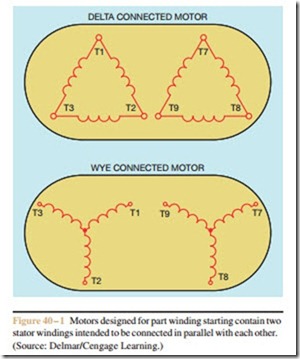Part winding starting is another method of reducing the starting current of squirrel cage induction motors. Mo- tors designed to be used for part winding starting contain two separate stator windings (Figure 40 – 1). The stator windings may be wye or delta connected, depending on the manufacturer. These two windings are designed to the connected in parallel with each other. When the motor is started, only one of the windings is connected to the power line. Since only half the motor winding is used during starting, this method of starting is called part winding starting. Part winding starting reduces the normal locked rotor current to approximately starting and the torque is reduced to approximately 50%. It should be noted that neither of the two windings is individually capable of withstanding the starting current for more than a few seconds. The first winding will overheat rapidly if the second winding is not connected within a very short period of time. As a general rule, a time delay of two to three seconds is common before the second winding is connected in parallel with the first.
Part winding starting is accomplished by bringing out both sets of motor leads so that external connection is possible (Figure 40 – 2). When the Start button is pressed, motor starter 1M energizes and connects the first motor windings to the line. The normally open 1M auxiliary contact closes and starts on-delay timer TR. After a 2 second time delay, timed contact TR closes and energizes motor starter 2M. This causes the 2M load contacts to close and connect the second stator winding to the power line.
Overload Protection
Note that two motor starters are used in the circuit, and each contains an overload relay. Each winding is individually protected by thermal overload heaters. The heaters for each overload relay should be sized at one half the motor nameplate current. The contacts of both overload relays are connected in series so that an overload on either relay will disconnect both motor windings. It should also be noted that since each starter
carries only half the full load current of the motor, the starter size can generally be reduced from what would be required for a single starter. Another advantage of part winding starters is that they provide closed transition starting, since the motor is never disconnected from the power line during the starting time.


